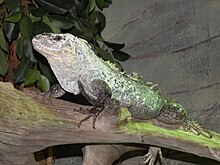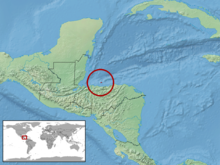| Ctenosaura bakeri | |
|---|---|

| |
| Scientific classification | |
| Domain: | Eukaryota |
| Kingdom: | Animalia |
| Phylum: | Chordata |
| Class: | Reptilia |
| Order: | Squamata |
| Suborder: | Iguania |
| Family: | Iguanidae |
| Genus: | Ctenosaura |
| Species: | C. bakeri
|
| Binomial name | |
| Ctenosaura bakeri Stejneger, 1901
| |

| |
| Synonyms[3] | |
Ctenosaura bakeri, also known as the Utila spiny-tailed iguana, Baker's spinytail iguana, swamper or wishiwilly del suampo, is a critically endangered species of spinytail iguana endemic to the island of Utila, one of the Islas de la Bahía off the coast of Honduras in the Caribbean.[1]
The Utila iguana is the only species of iguana and one of only two species of lizard to exclusively inhabit brackish mangrove swamps, forced there due to competition from larger species.[4] It is the smallest of the three species of iguana found on Utila, and unique among spiny-tailed iguanas as it is born a dark color as opposed to bright green or yellow.[5] It is arboreal and primarily herbivorous, although it can be an opportunistic carnivore.[6] Males may grow up to 76 centimeters (30 in) in length, while females are smaller, with a length of up to 56 centimeters (22 in). Eggs are laid in sandy beaches and hatch about 60–76 days later, with the hatchlings returning to live in the mangrove forests.
Brought to the brink of extinction by the 1990s due to hunting, it was brought back to international attention by German herpetologist Dr. Gunther Köhler and his book Reptiles of Central America.[7] Although several zoos and wildlife associations have instituted programs for the iguanas on Utila, the species still finds itself threatened due to overhunting and may face more of a threat in the form of habitat loss.[1] Extreme conservation efforts are in place to try to prevent this species from going extinct.[8]
- ^ a b c Maryon, D.; Ardon, D.; Martinez, A.; Clayson, S.; Pasachnik, S.A. (2018). "Ctenosaura bakeri". IUCN Red List of Threatened Species. 2018: e.T44181A125203850. doi:10.2305/IUCN.UK.2018-1.RLTS.T44181A125203850.en. Retrieved 13 November 2021.
- ^ "Appendices | CITES". cites.org. Retrieved 2022-01-14.
- ^ "Ctenosaura bakeri ". The Reptile Database. www.reptile-database.org.
- ^ Cite error: The named reference
Alexwas invoked but never defined (see the help page). - ^ Cite error: The named reference
GKwas invoked but never defined (see the help page). - ^ Cite error: The named reference
DGwas invoked but never defined (see the help page). - ^ Cite error: The named reference
PEwas invoked but never defined (see the help page). - ^ Cite error: The named reference
malfattiwas invoked but never defined (see the help page).
